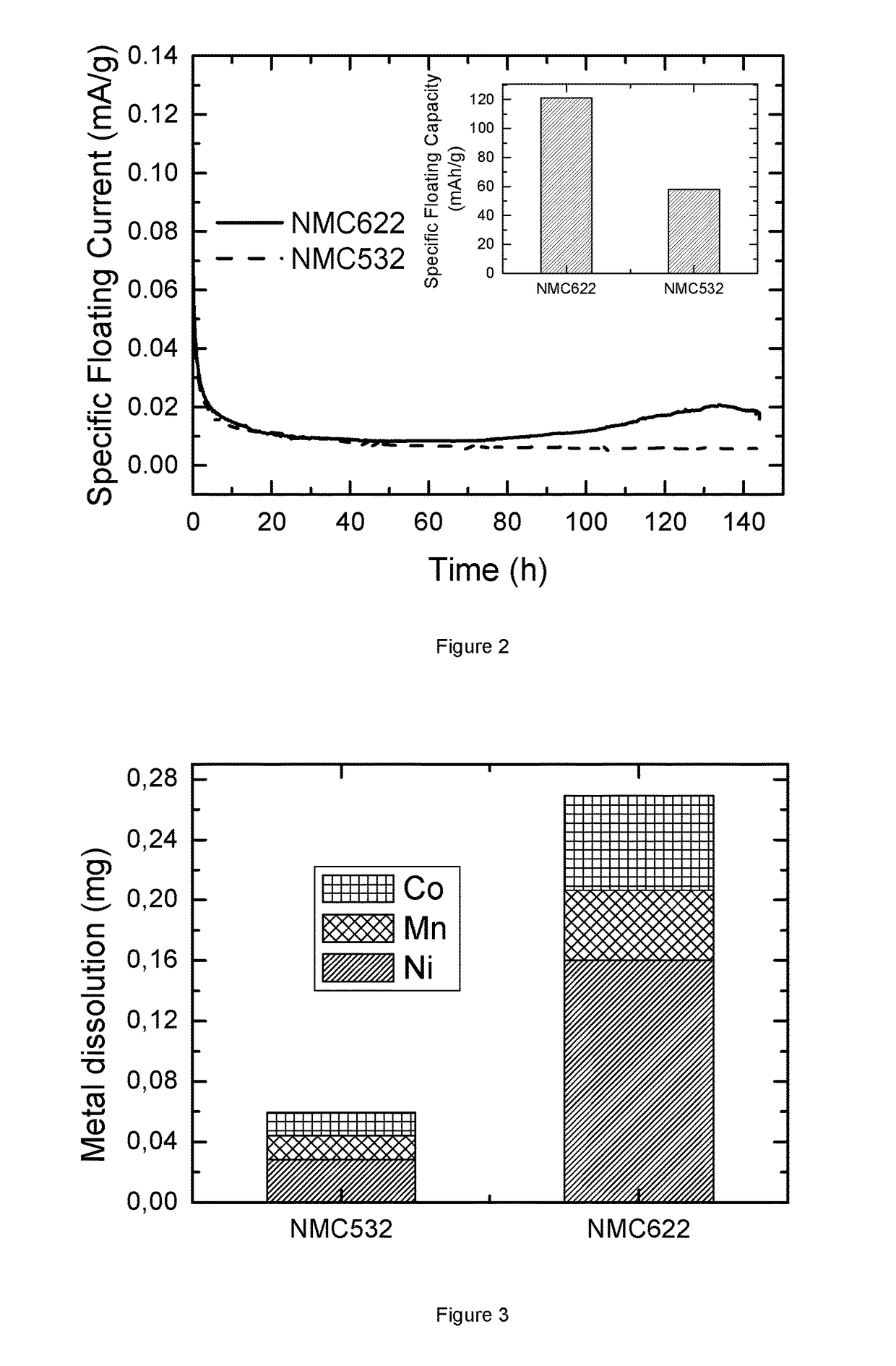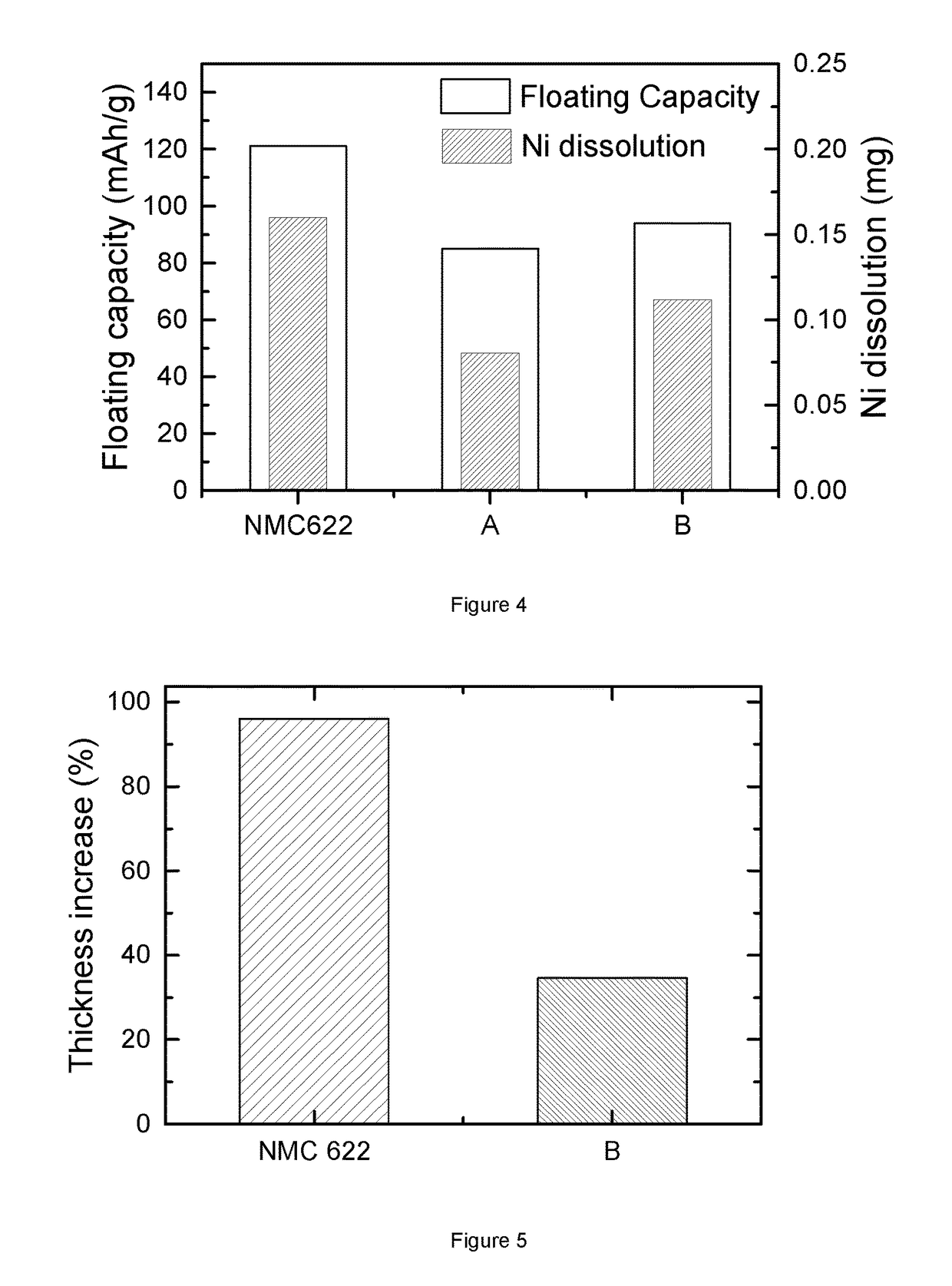Lithium Metal Oxide Cathode Powders for High Voltage Lithium-Ion Batteries
a lithium-ion battery and cathode powder technology, applied in the direction of cell components, nickel compounds, electrochemical generators, etc., can solve the problems of low efficiency, low efficiency, and inability to complete replacement, and achieve the effect of substantial increase of the ratio
- Summary
- Abstract
- Description
- Claims
- Application Information
AI Technical Summary
Benefits of technology
Problems solved by technology
Method used
Image
Examples
example 1
Test of Bare NMC622 and Bare NMC532
[0120]FIG. 2 illustrates the floating test of coin cells, where the positive electrode materials is pristine Li1.01(Ni0.6Mn0.2Co0.2)0.99O2(bare NMC622) and pristine Li1.02[Ni0.5Mn0.3Co0.2]0.98O2(bare NMC532), both prepared according to step (a) in “Preparation of NMC powder and surface modification of NMC powder”. The coin cell is charged at a constant voltage of 4.6V at 50° C. for 144 hours. The plot shows the evolution of floating current over time (in h). The solid line corresponds to NMC622 while the dash line is for NMC532. The current unit is mA / g where the mass refers to the active cathode mass. Ignoring the drop at the beginning, which is due to the switch of charging mode, it is clear that the floating current of NMC622 gradually increases during high voltage charge, while the current of NMC532 basically keeps constant. The lift of current indicates more metals dissolving from NMC622 than NMC532 cathode material. This can be confirmed from...
example 2
Test of Bare NMC622, Alumina Coated NMC622 and Alumina-LiF Coated NMC622
[0124]FIG. 4 illustrates the floating test of coin cells, where the positive electrode materials is resp. bare NMC622, “A” and “B”, and the negative electrode material is graphite. Here, “A” represents cathode material Li1.01(Ni0.6Mn0.2Co0.2)0.99O2 coated with a surface layer containing an Al gradient. Sample “A” is prepared through steps (a) and (b) in the “Preparation of NMC powder and surface modification of NMC powder”. “B” represents cathode material Li1.01(Ni0.6Mn0.2Co0.2)0.99O2 coated with a surface layer containing both an Al and F gradient according to the invention. Sample “B” is prepared through steps (a) and (c) in the “Preparation of NMC powder and surface modification of NMC powder”. The floating condition is as follows: charging voltage is set as 4.6V; temperature is at 50° C.; charging time is 144 hrs.
[0125]The left y-axis gives the specific floating capacity Qfloating of the three kinds of catho...
example 3
est of Alumina and LiF-Coated NMC622
[0126]FIG. 5 provides the bulging test results of two kinds of full cells. The bulging results are represented by the increase percentage of full cell thickness after storage at 90° C. for 4 hrs. The sole difference between these two full cells is the cathode material: one employs bare NMC622, while the other comprises material “B”. From the Figure, it is clear that the bare NMC622 based full cell shows nearly 100% thickness increase, while the “B” based full cell only presents about 40% thickness increase. Thus, “B” cathode material has less side reactions that produce gases during a bulging test. This further demonstrates that alumina and LiF coating plays a role in preventing side reaction between electrolyte and NMC622. There is agreement between the bulging and floating results of “B”, since both confirm the reduction of side reactions by alumina and LiF coating. To a certain extent, the performance of a coin cell in the floating test, where ...
PUM
 Login to View More
Login to View More Abstract
Description
Claims
Application Information
 Login to View More
Login to View More - R&D
- Intellectual Property
- Life Sciences
- Materials
- Tech Scout
- Unparalleled Data Quality
- Higher Quality Content
- 60% Fewer Hallucinations
Browse by: Latest US Patents, China's latest patents, Technical Efficacy Thesaurus, Application Domain, Technology Topic, Popular Technical Reports.
© 2025 PatSnap. All rights reserved.Legal|Privacy policy|Modern Slavery Act Transparency Statement|Sitemap|About US| Contact US: help@patsnap.com



